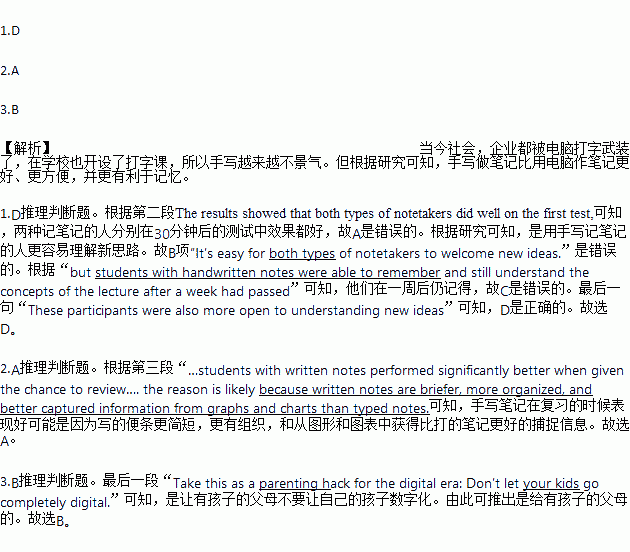题目内容
Handwriting is quickly becoming a dying art. Few businesses can run nowadays without computers, giving keyboard shortcuts an unprecedented importance. Elementary and high schools across the country now view typing courses as essential to their curricula. But what are we losing as handwriting loses its significance in society?
Brain power, according to science. Researchers from Princeton University and the University of California, Los Angeles conducted a series of studies to demonstrate the differences between students who wrote out their notes and those who typed notes. Participants took notes on a lecture using one of the two methods and were tested on the material 30 minutes after the lecture and again a week later. The results showed that both types of notetakers did well on the first test, though longhand notetakers had a stronger grasp of the overall concept, but students with handwritten notes were able to remember and still understand the concepts of the lecture after a week had passed. These participants were also more open to understanding new ideas.
At the University of Nebraska, educational psychologist Kenneth Kiewra held a similar study, where some students were tested immediately following a PowerPoint lecture and others had a chance to review their notes before being tested. Those who took notes on a laptop had a slight advantage on the test right after the lecture, but students with written notes performed significantly better when given the chance to review. Kiewra told the Wall Street Journal that the reason is likely because written notes are briefer, more organized, and better captured information from graphs and charts than typed notes.
Computers aren’t going away anytime soon, but that doesn’t mean paper notebooks need to become obsolete(过时). In fact, it’s best to start using them at an early age. University of Indiana researchers compared brain scans of five year olds, some of whom practiced printing letters and some who just looked at the letters. Those who wrote out the letters had more enhanced and “adult-like” neural activity.
Take this as a parenting hack for the digital era: Don’t let your kids go completely digital.
1.It can be inferred from the second paragraph that ________.
A. Not both types of notetakers did well on the material test 30 minutes after the lecture.
B. It’s easy for both types of notetakers to welcome new ideas.
C. Students who wrote notes out could only remember the lecture in a week.
D. Students who typed notes could have a better understanding of the material.
2.Why students with written notes performed much better when given the chance to review according to Kiewar?
A. Because the written notes are much more convenient and accessible.
B. Because they have a higher level of intelligence than those with typed notes.
C. Because they are born adapting themselves to new ideas easily.
D. Because the typed notes are always without any references.
3.The passage mainly provides suggestions for ________.
A. students B. parents
C. schools D. enterprises

